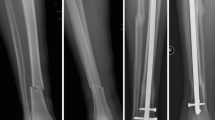Abstract
A study of 24 patients who sustained an extra-articular fracture of the distal third of the tibial shaft was performed to determine the effect of the type of treatment, open reduction and internal fixation (ORIF) or closed reduction and intramedullary (IM) nailing, on the occurrence of malalignment. All patients were treated in our clinic between 1993 and 2001 for a fracture in the distal third of the tibia. Twelve patients treated with ORIF were matched to 12 patients treated with IM nailing, with regard to gender, age decade, and the AO classification of the fracture. The group treated with IM nailing was assessed after a mean 6.0 years versus ORIF after a mean of 4.5 years. Two patients treated with ORIF versus six patients treated with IM nailing had a malalignment of the tibia. Furthermore, we found no difference with regard to time to union, non-union, hardware failure or deep infections between ORIF and IM nailing. Our results suggest that control of alignment is difficult with IM nailing of distal tibial fractures. For optimal alignment we advise considering the use of ORIF for closed and type I open extra-articular fractures in the distal third of the tibia.
Résumé
Nous avons étudié 24 patients présentant une fracture extra articulaire du tiers distal de la diaphyse tibiale afin de déterminer quel était le meilleur type de traitement. Les patients ont été traités soit par réduction sanglante et fixation interne (ORIF) soit par réduction fermée et enclouage centromédullaire. Tous les patients ont été traités dans notre établissement entre 1993 et 2001. Douze patients traités par ostéosynthèse interne ont été comparés à 12 patients traités par enclouage centromédullaire, ces deux groupes étant comparables également en terme de sexe, d’âge, de classification AO. Le groupe traité par enclouage centromédullaire a été suivi pendant une moyenne de 6 ans alors que le groupe par ostéosynthèse, sur une moyenne de 4,5 ans. Deux patients traités par ostéosynthèse interne versus 6 patients traités par enclouage centromédullaire ont présenté un cal vicieux du tibia. Nous n’avons pas trouvé de différence significative sur le plan de la consolidation, du taux de pseudarthrose, du débricolage ou sur le taux d’infection. Nos résultats nous permettent de penser qu’il est plus difficile de traiter ce type de fracture avec l’enclouage centromédullaire et, nous conseillons, pour ce type de fractures fermées ou ouvertes de type I de faire un traitement pas ostéosynthèse interne.

Similar content being viewed by others
References
Bone LB, Sucato D, Stegemann PM et al (1997) Displaced isolated fractures of the tibial shaft treated with either a cast or intramedullary nailing. J Bone Joint Surg Am 79:1336–1341
Court-Brown CM, Gustilo T, Shaw AD (1997) Knee pain after intramedullary tibial nailing: its incidence, etiology, and outcome. J Orthop Trauma 11:103–105
Duda GN, Mandruzzato F, Heller M et al (2001) Mechanical boundary conditions of fracture healing: borderline indications in the treatment of unreamed tibial nailing. J Biomech 34:639–650
Duda GN, Mandruzzato F, Heller M et al (2003) Mechanical borderline indications in the treatment of unreamed tibial nailing. Unfallchirurg 106(8):683–689
Hooper GJ, Keddell RG, Penny ID (1991) Conservative management or closed nailing for tibial shaft fractures. A randomized prospective trial. J Bone Joint Surg Br 73(1):83–85
Im GI, Tae SK (2005) Distal metaphyseal fractures of tibia: a prospective randomized trial of closed reduction and intramedullary nail versus open reduction and plate and screws fixation. J Trauma 59(5):1219–1223
Insall JN, Dorr LD, Scott RD et al (1989) Rationale of the Knee Society clinical rating system. Clin Orthop 248:13–14
Jaarsma RL, Bruggeman AW, Pakvis DF et al (2004) Computed tomography determined femoral torsion is not accurate. Arch Orthop Trauma Surg 124(8):552–554
Kahn KM, Beals RK (2002) Malrotation after locked intramedullary tibial nailing: three case reports and review of the literature. J Trauma 53(3):549–552
Karladani AH, Granhed H, Edshage B et al (2000) Displaced tibial shaft fractures. A prospective randomized study of closed intramedullary nailing versus cast treatment in 53 patients. Acta Orthop Scand 71(2):160–167
Krettek C, Stephan C, Schandelmaier P et al (1999) The use of Poller screws as blocking screws in stabilising tibial fractures treated with small diameter intramedullary nails. J Bone Joint Surg Br 81:963–968
Megas P, Zouboulis P, Papadopoulos AX, Karageorgos A, Lambiris E (2003) Distal tibial fractures and non-unions treated with shortened intramedullary nail. Int Orthop 27(6):348–351
Milner SA (1997) A more accurate method of measurement of angulation after fractures of the tibia. J Bone Joint Surg Br 79:972–974
Nork SE, Schwartz AK, Agel J, Holt SK, Schrick JL, Winquist RA (2005) Intramedullary nailing of distal metaphyseal tibial fractures. J Bone Joint Surg Am 87(6):1213–1221
Puno RM, Vaughan JJ, Stetten ML et al (1991) Long-term effects of tibial angular malunion on the knee and ankle joints. J Orthop Trauma 3:247–254
Van der Schoot DK, den Outer AJ, Bode PJ et al (1996) Degenerative changes at the knee and ankle related to malunion of tibial fractures. 15-year follow-up of 88 patients. J Bone Joint Surg Br 78:722–725
Wissing H, Buddenbrock B (1993) Determining rotational errors of the femur by axial computerized tomography in comparison with clinical and conventional radiologic determination. Unfallchirurgie 19(3):145–157
Author information
Authors and Affiliations
Corresponding author
Rights and permissions
About this article
Cite this article
Janssen, K.W., Biert, J. & van Kampen, A. Treatment of distal tibial fractures: plate versus nail. International Orthopaedics (SICO 31, 709–714 (2007). https://doi.org/10.1007/s00264-006-0237-1
Received:
Revised:
Accepted:
Published:
Issue Date:
DOI: https://doi.org/10.1007/s00264-006-0237-1




